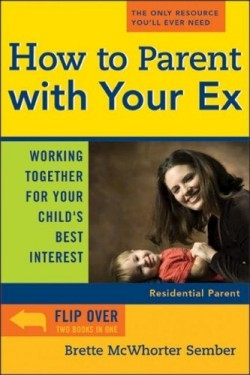
How to Parent with Your Ex
Working Together for Your Childs Best Interest
Divorce, at best, is an emotionally draining and complex legal process, and when there are children involved, the stress can increase exponentially. Much has been written about not using kids as a pawn during a divorce and the aftermath, yet not enough information has been produced to explain exactly how to do that. With this new book, that is about to change.
The author, an attorney who used to practice in the area of divorce and family law, has written several other books regarding the divorce and custody process. In this volume, she turns her attention to helping both sides of the divorce. The book itself is a “flip” book, with one half written for the residential parent and the other for the non-residential parent. While both sides have many issues in common, the residency status can make a significant difference in lifestyle and support issues. This unique approach levels the playing field for both sides, and Sember encourages both sides to read the other’s part of the book to have a better understanding of what the other parent is facing.
Both sides of the book cover legal and practical matters, such as working with one’s ex to set consistent rules for both homes, how to work through uncomfortable emotions, the importance of treating the other parent respectfully, and managing the legal ramifications of custody in terms of schools, doctors, new spouses, and even death. These are all uncomfortable issues, but for the best interest of the child involved, parents should deal with them, and Sember gives a practical workbook showing exactly how to do so.
Sember never loses sight of the fact that the child’s feelings and needs must be taken into account. When discussing conflicts over visitation scheduling, she notes, “When all of you lived together in one home, did your child have to skip the promo or a soccer game because one of you wanted to spend time with him or her? … If you or the other parent constantly require a child to skip activities, all you will get out of it will be resentment.” It would seem obvious to do so, but for parents caught up in acrimonious battles over schedules, the child’s wishes can get lost. This is perhaps one of the most positive aspects of this book—the gentle but firm reminder that the children must come first.
The book’s friendly style welcomes parents on both sides and urges them to appreciate the difficulties faced by the other parent. Full of practical advice and strong encouragement, this book should be read by all parents approaching a divorce or struggling to get along after one.
Reviewed by
Amy Rea
Disclosure: This article is not an endorsement, but a review. The publisher of this book provided free copies of the book to have their book reviewed by a professional reviewer. No fee was paid by the publisher for this review. Foreword Reviews only recommends books that we love. Foreword Magazine, Inc. is disclosing this in accordance with the Federal Trade Commission’s 16 CFR, Part 255.
